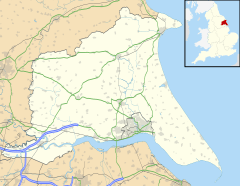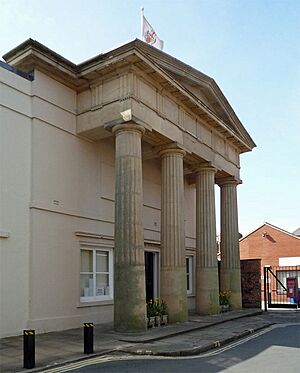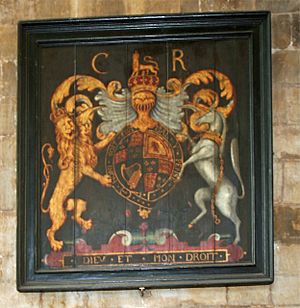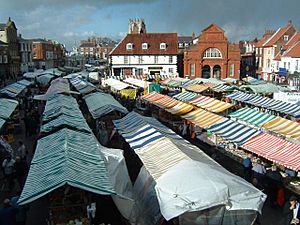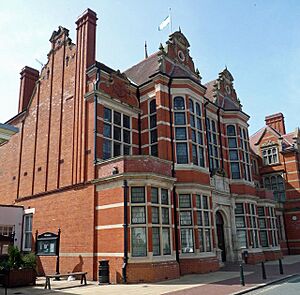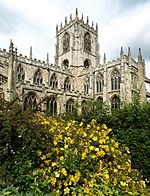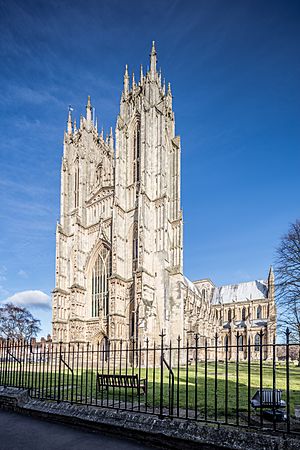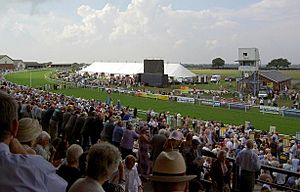Beverley facts for kids
Quick facts for kids Beverley |
|
|---|---|
| Town and civil parish | |
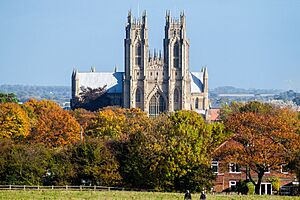 Beverley Minster |
|
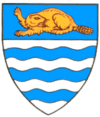 Coat of arms of Beverley Town Council |
|
| Population | 30,587 (2011 census) |
| OS grid reference | TA035399 |
| Civil parish |
|
| Unitary authority | |
| Ceremonial county | |
| Region | |
| Country | England |
| Sovereign state | United Kingdom |
| Post town | BEVERLEY |
| Postcode district | HU17 |
| Dialling code | 01482 |
| Police | Humberside |
| Fire | Humberside |
| Ambulance | Yorkshire |
| EU Parliament | Yorkshire and the Humber |
| UK Parliament |
|
| Website | www.beverley.gov.uk |
Beverley is a historic market town in the East Riding of Yorkshire, England. It's about 27 miles (43 km) south-east of York and 6 miles (10 km) north-west of Hull. In 2021, the town had a population of around 30,930 people. Beverley is also the main town of the East Riding of Yorkshire.
The town was started in the 600s by John of Beverley. He built a church here. Back then, it was called Inderawuda. This name meant "in the wood of the men of Deira".
Around 850, Vikings took control of the area. Later, Beverley became part of the Kingdom of England. John of Beverley became a saint in 1037. This made Beverley a popular place for pilgrims throughout the Middle Ages.
The town grew a lot under the Normans. It became a major centre for trading wool. At one point, it was the tenth-largest town in England! However, after the English Reformation, Beverley became less important.
Today, Beverley has many famous places. These include Beverley Minster, Westwood common, North Bar gate, St Mary's Church, and Beverley Racecourse. The city of Beverly, Massachusetts in the USA was named after Beverley. This American city then inspired the name for Beverly Hills, California.
Contents
History
Early Beginnings and Vikings
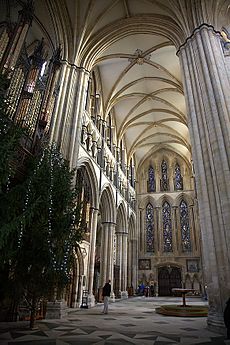
Beverley's story began in the 600s. This was during the time of the Anglian kingdom of Northumbria. The first building was a Christian church. It was dedicated to St John the Evangelist. This church was founded by the Bishop of York, who became known as John of Beverley. People believed he performed miracles. He was later made a saint.
Around 850, the monastery here was quickly left empty. Historians think this was because of the Great Heathen Army of Vikings. They invaded England and set up the Kingdom of Jórvík in Yorkshire. But in the 900s, more people came to Beverley. They came to honour Saint John of Beverley.
Before a big battle, the King of England, Athelstan, visited Inderawuda. He prayed all night and had a vision of victory. In return, he helped the town grow. In the 900s, the town's name changed to Bevreli or Beverlac. This means "beaver-clearing" or "beaver-lake". This was because of the many beavers in the River Hull back then.
Beverley became an important Christian centre in Northern England. This was thanks to the last three Anglo-Saxon archbishops of York. It also grew as a trading hub. People made textiles, leather, and items from antler.
Normans and Medieval Times
After the Normans took over, many pilgrims came to Beverley. They heard about the miracles of Saint John. The Normans destroyed many towns in Yorkshire. This was because people in the North didn't like Norman rule. But Beverley was saved. The Normans heard about its saintly history.
In 1086, the Domesday Book recorded Beverley. It had about 19 households. In the 1100s, Beverley grew into a large town. It stretched from the North Bar area to the Beck. It was given borough status in 1122. Trade grew even more. Beverley traded a lot of wool with towns in the Low Countries that made cloth.
A big fire in 1188 destroyed many homes. It also damaged Beverley Minster. In the 1200s, Dominican and Franciscans friars came to Beverley. They built churches and buildings. Farmers and the archbishop had a disagreement about land rights. After a royal inquiry, the townspeople were given rights to use the Westwood and other areas for their animals.
The 1300s brought tough times to England. There were famines, the Black Death, and wars. But Beverley kept growing. By 1377, it was the 10th largest town in England.
Changes in Tudor Times

Beverley relied on pilgrims visiting. But the English Reformation changed this. It meant fewer pilgrims came, and Beverley's importance dropped. A local man, Cardinal John Fisher, was executed in 1535. He refused to accept King Henry VIII as head of the Church of England.
In 1536, about 500 men in Beverley joined a protest. It was part of the larger Pilgrimage of Grace against Henry's new religious laws. Henry broke away from Rome. He also closed monasteries, including the Dominican Friary in Beverley.
The Tudors set up the Council of the North to control the area. John Leland, a famous English historian, visited Beverley. He estimated the population was around 5,000. Beverley Minster was almost torn down. But local people, led by Richard Gray, saved it. During the time of Elizabeth I, Beverley got its own mayor. Edward Ellerker was the first. The gap between rich and poor grew in Beverley. This was due to high unemployment.
Civil War and Recovery
In the early 1600s, the plague caused many deaths in Beverley. The town was close to Hull. Hull refused to open its gates to Charles I before the English Civil War. The king stayed in Beverley for three weeks. The town initially supported the king. But Hull's Parliamentarians took Beverley, making the king leave.
Later, a Royalist army took the town back. They then tried to attack Hull again. Eventually, the Parliamentarians won the war. They closed pubs on Sundays and stopped theatre and race meetings. They also destroyed anything they thought was too fancy in churches.
Beverley Minster was saved, partly because of the powerful House of Percy family. They had memorials in the church. Quakers in Beverley faced harsh treatment. When Charles II became king, it was welcomed in Beverley. His royal coat of arms still hangs in the Minster.
In the 1600s, Beverley's trade improved a little. Most people worked in agriculture. During the Georgian era, Beverley became the main market town in the area. Old timber buildings were replaced with new Georgian ones. This helped the town regain its importance. During the Industrial Revolution, most people in Beverley still worked in farming. But some worked with iron.
Beverley had a cattle market for 1300 years. It was a centre for livestock trade until it closed. The site is now a supermarket car park.
Industrial Growth and Modern Times
In 1841, the town had about 8,671 people. Hodgsons Tannery (1816–1979) was a big employer. It turned animal hides into leather. Another tannery, Melrose Tanners, closed in 1986. Armstrong Patents Co. Ltd. (1917–1995) also employed many people. It made shock absorbers.
Beverley Shipyard opened in 1884. It built ships until 1977. From 1905 to 1962, Cook, Welton & Gemmell owned it. They built many trawlers for Hull's fishing fleet. During both world wars, the yard built minesweepers for the Royal Navy. The famous trawler Arctic Corsair was built here in 1960.
Some old entrances to the town were taken down. This was to make way for more traffic as the population grew. Communications improved when Beverley railway station opened in 1846. In 1884, Andrew Cochrane started a shipyard. It was bought by Cook, Welton & Gemmell in 1901.
A military base, Victoria Barracks, opened in 1878. It closed in 1977. Now, the only army presence is the Defence School of Transport nearby. In the First World War, the Royal Flying Corps had an airfield on the Westwood. This site is now Beverley Racecourse.
During the Second World War, nearby Hull was heavily bombed. But Beverley was lucky and didn't suffer much. Since the war, Beverley has grown and changed. Thousands of tourists visit each year. They come to see the historic buildings and the racecourse.
In 2007, Beverley was named the best place to live in the UK. This was in a study by the Royal Bank of Scotland. In late 2015, a new shopping and entertainment complex opened. It includes a cinema and a hotel. East Riding College also moved to this new area.
Landmarks
Beverley has many famous buildings and places:
- Newbegin House – built in 1757
- Beverley Minster – mostly finished by 1420
- St Mary's Church – finished around 1530
- North Bar – built in 1409
- The Guild Hall – from the 15th century
- Beverley Friary – from 1539
- The Market Cross – built in 1714
- Beverley Memorial Hall – built in 1959
- Black Mill – built in 1803
- The Corn Exchange & Public Baths – built in 1885 (now a department store)
- Sessions House – built in 1814 (now a spa)
- The Hall Lairgate – built in 1750
- Beverley Racecourse – started in 1767
- 11 Ladygate, Beverley – an early medieval shop
Climate
| Climate data for DST Leconfield (1991–2020) | |||||||||||||
|---|---|---|---|---|---|---|---|---|---|---|---|---|---|
| Month | Jan | Feb | Mar | Apr | May | Jun | Jul | Aug | Sep | Oct | Nov | Dec | Year |
| Mean daily maximum °C (°F) | 7.2 (45.0) |
8.1 (46.6) |
10.3 (50.5) |
13.0 (55.4) |
15.8 (60.4) |
18.8 (65.8) |
21.3 (70.3) |
21.1 (70.0) |
18.3 (64.9) |
14.2 (57.6) |
10.2 (50.4) |
7.5 (45.5) |
13.8 (56.8) |
| Mean daily minimum °C (°F) | 1.6 (34.9) |
1.6 (34.9) |
2.8 (37.0) |
4.2 (39.6) |
6.8 (44.2) |
9.7 (49.5) |
11.8 (53.2) |
11.9 (53.4) |
10.0 (50.0) |
7.4 (45.3) |
4.2 (39.6) |
1.9 (35.4) |
6.2 (43.2) |
| Average rainfall mm (inches) | 53.1 (2.09) |
49.5 (1.95) |
42.9 (1.69) |
45.3 (1.78) |
44.5 (1.75) |
64.3 (2.53) |
54.7 (2.15) |
61.5 (2.42) |
58.2 (2.29) |
64.7 (2.55) |
64.7 (2.55) |
57.7 (2.27) |
660.9 (26.02) |
| Average rainy days (≥ 1 mm) | 11.9 | 10.6 | 9.4 | 9.4 | 9.0 | 9.9 | 9.4 | 9.9 | 9.4 | 11.0 | 12.5 | 11.5 | 124.0 |
| Mean monthly sunshine hours | 62.1 | 86.9 | 124.3 | 161.7 | 204.2 | 175.1 | 195.6 | 181.2 | 144.2 | 107.3 | 72.4 | 59.9 | 1,575 |
| Source: Met Office | |||||||||||||
Governance
In the Middle Ages, Beverley was run by aldermen called "the twelve keepers". They looked after the town and kept law and order. The local government changed in 1835. It continued until 1974. In 1974, Beverley joined with other areas to form a bigger borough. Since 1996, it has been part of the East Riding of Yorkshire district. It is the main town of the county.
Beverley used to have its own MPs (people who represent the town in the national government). It could elect two MPs from 1563. Only certain people, called "freemen," could vote. Elections became very unfair. So, the constituency was stopped in 1870.
Later, Beverley became part of different constituencies. Since 1997, it has been part of the Beverley and Holderness constituency. This area usually votes for the Conservative Party.
In 2019, the Liberal Democrats gained many seats in local elections. They took control of the Town Council. They also gained seats on the East Riding of Yorkshire Council.
| Position | Current representatives |
|---|---|
| Member of Parliament | Graham Stuart, Conservative, elected 2005 |
| East Riding of Yorkshire Council |
ST MARY'S WARD |
| Beverley Town Council | Peter Astell – Liberal Democrats, Tom Astell – Liberal Democrats, Dave Boynton – Liberal Democrats, Ian Gow – Independent, Denis Healy – Liberal Democrats, Chloe Hopkins – Labour, David Horsley – Liberal Democrats, Duncan Jack – Independent, Linda Johnson – Liberal Democrats, Margaret Pinder – Labour, David Tucker – Liberal Democrats, Ann Willis – Labour, Clare Wildey – Labour |
Planned Expansion
In 2014, local authorities planned to build 3,300 new houses in Beverley. This would make the town 20% bigger. The council said that the East Riding area is popular. Many people want to move there. Some residents are against these plans.
Education
Beverley is home to the oldest state school in England. It is Beverley Grammar School. Saint John of Beverley founded the school in 700 AD. Many famous people have gone there. These include chemist Smithson Tennant, who discovered iridium and osmium. Also, Thomas Percy from the Gunpowder Plot, and footballer Paul Robinson. Today, the school has about 800 students.
There are other schools in Beverley. Beverley High School is a comprehensive school for girls. It has about 850 students. Their GCSE test results are very good. Beverley Grammar School and Beverley High School share a sixth form. It is called the Beverley Joint Sixth.
Longcroft School is a school for both boys and girls. It has about 1,500 students. Longcroft School opened in 1951. It is home to the Longcroft Gospel Choir. This choir has performed in places like Disneyland Paris. They have also released two albums. In 2015, the choir was chosen to perform at the opening of the 2015 Rugby World Cup in London.
East Riding College has a campus in Beverley. The college offers different courses. These are for students leaving school and for adults.
Media
Beverley and the East Riding area are served by the East Riding Mail. This newspaper is a sister paper to the Hull Daily Mail. The Beverley Guardian newspaper was printed for 160 years. But it stopped in September 2016.
Beverley has two local online magazines. They are Just Beverley and HU17.net.
Radio stations like BBC Radio Humberside and Hits Radio East Yorkshire & North Lincolnshire serve the town. They are based in nearby Hull. Local TV news is from BBC Yorkshire and Lincolnshire and ITV Yorkshire.
Kingstown Hospital Radio serves the local hospital. Beverley also has its own radio station, 107.8 Beverley FM. It broadcasts from a studio in the town.
Some scenes from the 1954 film Lease of Life were filmed in Beverley.
Religion
Most people in Beverley are Christian. In the 2001 census, 79.9% of people said they were Christian. This was 8% higher than the national average.
Beverley Minster has a tomb said to hold the bones of Saint John of Beverley. He founded a monastery here, which led to the town's growth. Another saint from Beverley is Saint John Fisher. The Minster is a Grade I listed building.
The Church of England has three churches in Beverley. These are Beverley Minster, St Mary's Church, and St Nicholas Church. St Mary's Church is also a Grade I listed building. Beverley has a suffragan bishopric. This means it has a special bishop who helps the Archbishop of York.
There is one Roman Catholic church in Beverley. It is called St John's. Methodism also has about three places of worship in Beverley. Latimer Congregational Church is in the east of Beverley.
Quakers have worshipped in Beverley for a long time. Their current meeting house was built in 1961. Missionaries from the Church of Jesus Christ of Latter-day Saints arrived in Beverley in 1850. They built a large chapel in 1963. It was made bigger in the late 1990s.
Culture and Amenities
Market day is a big part of Beverley's culture. A smaller market is held on Wednesday. But the main market is on Saturday, with many stalls. Throughout the year, Beverley hosts various music festivals. These include the Early Music Festival in May. The Beverley Folk Festival in June has three days of folk music and comedy. There's also a Jazz Festival in August.
Sunday Live is a monthly music event at the Beverley Memorial Hall. Beverley also has a popular Male Voice Choir.
Beverley hosts an annual literature festival and a kite festival. There's also a puppet festival every two years. Since 2006, Beverley Town Council has run an annual food festival in October. It has 70 stalls selling local food. There are also cooking shows and street entertainment. Thousands of people attend this event. St Mary's Church held the first real ale and cider festival in 2012. Over 2,000 people came. The festival now takes place at the Beverley Memorial Hall.
In sports, horse racing is very popular. Beverley Racecourse has been there since at least 1690. Its first grandstand was built in 1767. The town's football team is Beverley Town F.C.. They play in the Northern Counties East League. Beverley hosted the 2006 British National Cycling Championships. Beverley Westwood is home to the oldest golf club in Yorkshire. It was founded in 1889. Beverley RUFC plays Rugby Union. The Tour de Yorkshire cycling race passes through North Bar. A weekly 5k parkrun is held at the Westwood every Saturday.
Beverley has many public houses (pubs). Some are tourist attractions. The Sun Inn is the town's oldest pub, from around 1530. There are over 40 pubs in Beverley. Most have been there for over a century. The White Horse Inn, or "Nellie's," still uses authentic gas lighting.
A Post Office opened in 1905. It closed in 2020. Post Office services are now in a nearby shop.
Beverley's first cinema, the Marble Arch, opened in 1916. It closed in 1967 and was demolished. The site is now a supermarket.
The Museum of Army Transport moved to Beverley in 1983. It closed in 2003 due to lack of money. The last surviving Blackburn Beverley aircraft was on display there. This area is now Flemingate, a shopping centre.
The current fire station opened in 1982. The old fire station is now a doctor's surgery. The police station is part of a court complex built around 1805. The old courthouse is now a spa. The old prison is a private home.
Beverley used to have two hospitals. The Westwood Hospital closed in 2011. Beverley Cottage Hospital closed by 1996. Beverley Community Hospital opened in 2012 on a new site.
The East Riding Theatre opened in 2014. It is in an old chapel. It is run by volunteers and shows plays and music.
The Beverley Treasure House has a library, archives, a museum, and an art gallery.
Town Fair
Beverley has had a fair since medieval times. In the past, fairs were for trading goods and animals. They were also places to meet people and hear news. Towns were given the right to hold fairs by the King. In the early 1100s, Archbishop Thurstan was allowed to hold four fairs a year. Each fair lasted up to five days. Beverley's medieval fairs were:
- Feast of St John of Beverley (7 May)
- Ascension Day (Early summer)
- Feast of St John the Baptist (21–25 June)
- Translation of St John of Beverley (25 October)
These four annual fairs continued until the 1900s. They were for selling cattle and horses. They were held on North Bar Within or Without. One of the market places was used for selling general goods. A toll was charged for horses entering the town.
By the 1900s, selling livestock at fairs had decreased. But the funfair part became very popular. These funfairs were held on Saturday Market. As the rides became bigger, Saturday Market was no longer suitable.
In 1959, the fair was moved from the Market Place. It was then held four times a year at Morton Lane car park. In 2002, this car park was sold. The town had no place for the fair. The council offered space on the Westwood. But the fair organisers insisted on a site "within the walls of Beverley". They said their Royal Charter gave them this right.
In 2003, the Beverley Town Fair returned to Saturday Market. The fair is now limited to one week a year. It starts on August Bank Holiday Sunday.
Transport
The town has Beverley railway station. It is on the Hull to Scarborough Line. Trains are run by Northern. There is also a limited service to London King's Cross. Before the 1960s, there was a direct line to York. A campaign is trying to reopen this line.
Beverley railway station opened in 1846. It was designed by George Townsend Andrews. It is now a Grade II listed building.
The 5-mile (8 km) £13 million A1079 Beverley Bypass opened in 1980. This road connects York and Hull. East Yorkshire Motor Services provides local bus services. They also have regular buses to Hull and nearby villages. Beverley has its own bus station.
Beverley Beck is a canal. It allows boats to reach the town from the River Hull. The beck is used by fishermen. They catch fish like pike, bream, and carp. In the past, Beverley Beck was important for trade. Beverley was a trading post of the Hanseatic League. Today, it is home to the Beverley Barge Preservation Society. Beverley also has a busy road junction called Grovehill. It has 42 traffic lights.
Literature
Beverley is the main setting for Domini Highsmith's "Father Simeon" trilogy: Keeper at the Shrine (1994), Guardian at the Gate (1995) and Master of the Keys (1996).
Notable people
- Julian Agyeman (born 1958), academic
- Jane Arden (1758–1840), schoolmistress and grammarian
- Ken Annakin (1914–2009), film director
- Lewis Bean (born 1992), rugby player
- William Binnington Boyce (1804–1889), philologist, clergyman
- Lindsey Chapman (born 1984), actress and TV and radio presenter
- Joseph Clay, United States Continental Congressman
- George Collison (1772–1847), academic, theologian
- James Robert Craig (born 1988), rugby player
- William Dixon (1808–1887), U.S. politician
- Frederick William Elwell (1870–1958), artist
- John Fisher (1469–1535), bishop, cardinal, saint, martyr
- Peter Goy (born 1938), footballer
- Anthony Hedges (1931–2019), composer
- Alfred Hutton (1839–1910), Victorian officer, antiquarian and swordsman
- Gerry Ingram (born 1947), footballer
- Andrea Jenkyns (born 1974), Member of Parliament Morley and Outwood
- Lisa Kay (born 1971), actress
- Jemma McKenzie-Brown (born 1994), Tiara Gold High School Musical 3: Senior Year
- Jack Marriott (born 1994), footballer
- Anna Maxwell Martin (born 1978), actress
- Joan of Leeds, 14th century runaway nun
- John Merbecke (1510–1585), theologian, musician
- Katie O'Brien (born 1986), tennis player
- Julia Pardoe (1806–1862), poet, novelist, historian
- Thomas Percy (1560–1605), gunpowder plotter
- Dave Phillips (born 1987), Great Britain men's national ice hockey team, Lake Erie Monsters (AHL)
- Paul Robinson (born 1979), footballer
- Suhayl Saadi (born 1961), writer
- Mike Score (born 1957), keyboardist, singer
- Calum Scott (born 1988), singer and songwriter
- Lizzie Simmonds (born 1991), swimmer
- Guy Smith (born 1974), 2003 24 Hours of Le Mans winner
- Neil Thompson (born 1963), footballer
- Eleanor Tomlinson (born 1992), actress
- Mary Wollstonecraft (1759–1797), writer and philosopher, lived in Beverley 1768–1774
- Curtis Woodhouse (born 1980), former professional footballer and boxer, and now the current manager of Tadcaster Albion
Twin towns
Beverley is twinned with:
- Nogent-sur-Oise in France
- Lemgo in Germany
Images for kids
See also
 In Spanish: Beverley para niños
In Spanish: Beverley para niños


